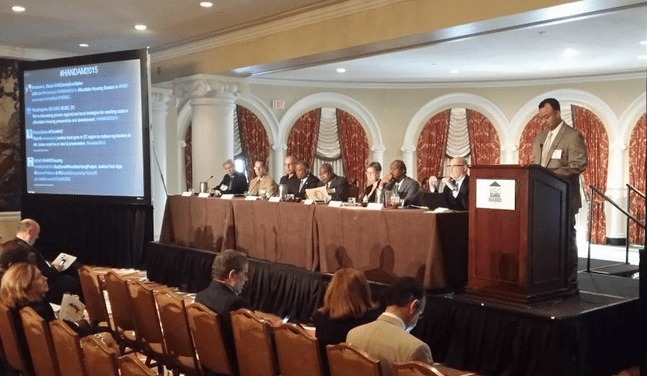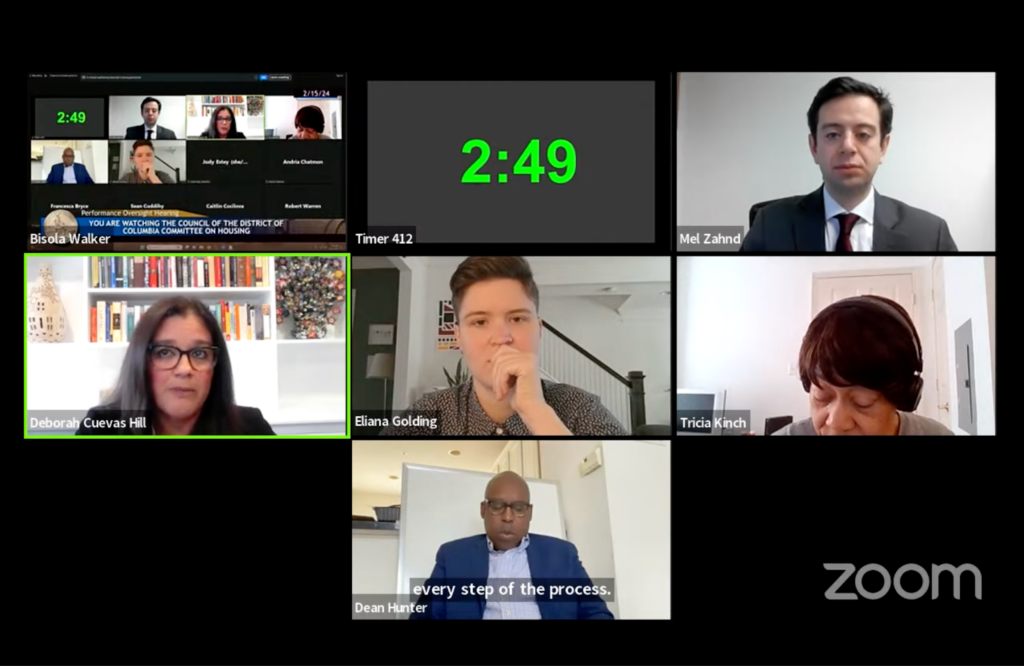Street Sense vendor Patty Smith recently qualified for housing with Woodley House, Inc.
“Everyone has been helping me, and asking me about my new place. It’s been so nice,” said Patty Smith. “I get to tell everyone who asks, ‘I have a home!'”
Smith described the transition into her new residence, saying that the hardest part of moving to Woodley House was missing friends she made during her six months living in a local shelter, but that didn’t alter the joy she felt in having a place to call her own.
“My case manager asked if I was ready to go to my new home … I grabbed my bags without another word,” Smith said. “There are two beds in the room, a dresser, a table, a lamp, and a radio. It’s beautiful.”
With three meals a day, a space of her own and the company of fellow residents, Smith said the move has vastly improved her quality of life. She appreciates the community and has become a welcome part of it.
On June 23, 2015, the Housing Association of Nonprofit Developers (HAND) held its Annual Meeting and Housing Expo to discuss how to make the kind of security and satisfaction Smith is experiencing a reality for more residents in the greater Washington area. The daylong event included a panel discussion on regional strategies to increase development and preservation of affordable housing.
“We need to stop having million dollar conversations about billion dollar problems,” opened David Bowers, vice president and Mid-Atlantic market leader for Enterprise Community Partners, Inc. regarding affordable housing discussions.
Housing experts and community leaders debated how public and private sector stakeholders can collectively make progress in the matters of affordable housing. Michael Bodaken, President of National Housing Trust, moderated the panel. s
“Housing is about building a community. It’s about keeping people where they need to be,” said Andy Shallal, owner and proprietor of Busboys & Poets. “Especially when we are talking about the vulnerable; the elderly and poor. They need community.”
Home Matters is an organization that shares Shallal’s emphasis on the importance of community in the ongoing discussion of affordable housing. A national movement to increase awareness and raise funds for the development of affordable housing and better communities across the country, Home Matters is striving to alter the public perception of the American Dream and establish a greater emphasis on community.
“The ‘American Dream’ used to be focused primarily on homeownership. We hope to re-define that dream to a more community-centered definition,” said Helen Malani, Home Matters’ Media Contact.
Malani expressed that Home Matters is striving to develop a more focused effort in affordable housing development. Many entities are working to improve the conditions and availability of affordable housing, but Malani believes those entities are working independently from one another. The result is that the light shining on the issue is not bright enough.
“Our goal is to create a collective voice that elevates the housing issue, because it can help solve other societal problems,” said Malani.
On December 2, 2014, Home Matters’ Redefining Home: A Design Challenge was opened for submissions. This design challenge — the first nationwide competition aimed at addressing community-focused affordable housing — challenges architects and designers to develop feasible housing designs that address stressors on low and moderate-income families, such as crime and neighborhood violence, low opportunities for economic development, lack of health care access, and poor schooling options. The competition’s winning submissions will be announced on September 15, 2015, at the Autodesk Gallery in San Francisco.
“The hope is that this multi-faceted competition addresses the community based American dream. The home can positively influence general health and wellness, education, safety, and economic conditions,” said Malani. “Communities today often associate a negative connotation to affordable housing developments. Modern architecture and aesthetic design can help break through that stigma—we believe that design is the future. We hope designs will go beyond just shelter, and help improve other societal problems.”
In the nation’s capital, affordable housing projects are embracing a new aesthetically modern design standard. The John and Jill Ker Conway Residence in the district’s NoMa neighborhood will provide 60 units of permanent supportive housing for formerly homeless veterans, 47 units of affordable housing for tenants making below 60% of the local median income, and 17 units of affordable housing for tenants making below 30% of the local median income, according to Sorg Architects. The 14-story residence was designed to maximize natural light inside the building; the northern and southern views from the building include some of D.C.’s most notable structures. Included in the design are spaces for services that will accommodate the social, medical, and emotional needs of tenants.

The leaders of the $33 million project hope to complete construction by the end of 2015. Financing has come from both public and private sources. A Wider Circle, a local nonprofit organization, plans to fully furnish the 60 permanent supportive housing units, assuring that they are move-in ready.
The United State Interagency Council on Homelessness estimates that individuals experiencing homelessness can cost the public between $30,000 and $50,000 per person per year. Many of the factors that drive up this cost are avoidable if a home can be provided for chronically homeless individuals. Dr. Joshua Bamberger, Medical Director for Housing and Urban Health for the San Francisco Department of Public Health reiterated the cost benefit of supportive and affordable housing. A home can reduce the costs associated with preventable public and emergency service uses, explained Bamberger.
“The best designed housing projects incorporate a mixed income population,” said Bamberger “A certain portion of units being dedicated to chronically homeless tenants, and the rest being divided between various low income levels is the ideal. It reduces the ghettoization and resulting stigma of the community.”
The importance of aesthetic design not only applies to the surrounding community but it helps the formerly homeless and low-income residents who will occupy the building, expressed Bamberger. Lighting, color, architecture, and community space can alleviate many of the stressors that formerly homeless and low-income tenants may experience. The duel benefit is that when buildings are aesthetically pleasing, members of the surrounding community are often more accepting of the residents that occupy them.
The importance of aesthetic design not only applies the surrounding community but it also helps the formerly homeless and low-income residents that will occupy the building, expressed Bamberger. Lighting, color, architecture, and community space can alleviate many of the stressors that formerly homeless and low-income tenants may experience. The duel benefit is that the surrounding community is often more accepting of architecturally appealing developments, and the residents that occupy them.








